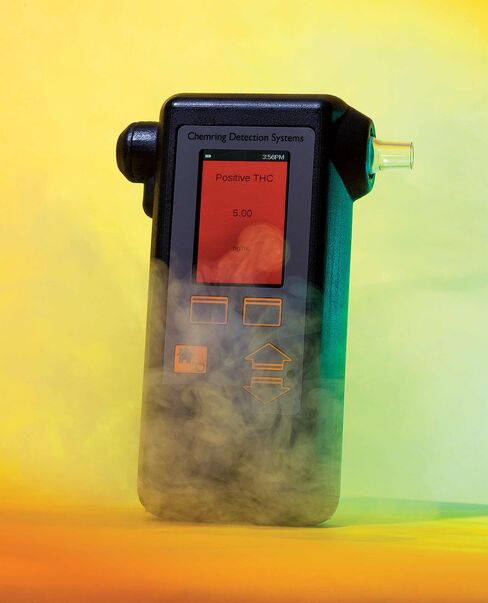Are you high?
Karen Weise
Illustrator: Steph Davidson
In states such as Washington and Colorado, the legalization of recreational marijuana use has brought a shadow market into the open. If you’re into this sort of thing, it’s probably made you a lot less paranoid. But as more people legally smoke up, state and local law enforcement face a buzzkill: There’s no quick way to know if a driver is stoned.
That’s partly because the science of highs is sketchy. A May study from the AAA Foundation for Traffic Safety concluded that there isn’t a reliable link between impairment and the level of THC, pot’s psychotropic agent, in a driver’s blood. Nonetheless, in Washington, as in many states, the legal limit is based on blood concentration. So officials are looking to a septuagenarian chemist to build a breathalyzer for weed. The chemist’s name, of course, is Herb.
Herb Hill, a professor at Washington State University, has spent more than four decades pioneering ways to detect chemicals—or, more accurately, to detect chemical signatures based on the movement of a substance’s component ions. His work helps various government and military inspectors swab laptops for explosives, sniff out mold-contaminated food, and find sarin gas on a battlefield.
As he prepares to retire next year, Hill and his last graduate student, Jessica Tufariello, are applying his techniques to test for pot.
Today, if cops in Seattle suspect a driver has exceeded the legal limit (5 nanograms of THC per milliliter of blood), they must call for specially trained colleagues to run a 12-point test examining the suspect’s light sensitivity, eyelid tremors, balance, and other factors. Then they’ll need a search warrant to draw a sample of the suspect’s blood at a nearby hospital.
The whole process can take hours, during which the drug could dissipate in the bloodstream. A breathalyzer could measure drug levels in the bloodstream or at least quickly determine whether a blood draw is warranted.
“It’s an interesting project to end on, and an important one,” Hill says, though he acknowledges the 5ng level he’s testing for is an unscientific legal guideline. “I haven’t seen anybody who has determined how that relates to being impaired.” He began thinking about building a breathalyzer for drugs in 2009 at the suggestion of his friend Nick Lovridge, a retired WSU political science professor who’d been doing research for the state on ways to reduce highway fatalities.
The chemistry professor was already planning for retirement, so he asked Tufariello for help. The pair originally planned to test for 10 common illicit substances but narrowed their focus to THC in 2012, after Washington voters approved a ballot measure legalizing pot.
Hill says he’s secured about $300,000 in funding commitments from Chemring Group, a British defense contractor with U.S. divisions that produce detection devices for chemical and biological agents. In exchange, Chemring has exclusive rights to use his and Tufariello’s work to develop a commercial breathalyzer.

The prototype of Chemring’s pot breathalyzer looks a little like an old-school Game Boy.
Photographer: David Brandon Geeting
First, the researchers tested a pure THC sample that’s commercially available in concentrations far too low to get high, and it produced the strong signal they’d hoped to see, indicating that marijuana can be detected using DMS. Then came the hard part—or the fun part if, again, you’re into this sort of thing: the field tests.
“When you breathe into a tube, everybody is going to have a different set of chemicals that come out,” says Jeff Okamitsu, Chemring’s chief technology officer, who’s overseeing the commercialization efforts. To make sure the machines wouldn’t yield false positives, Tufariello tried to replicate a marijuana smoker’s munchies. “I would go eat at Taco Bell and Thai Ginger and drink lots of coffee to contaminate my breath,” she says. So far, so good. None of the other stuff produced a signal similar to THC.
A university board approved the lab’s human testing protocol in 2014. Tufariello says she had no problem finding 14 students willing to get high for the sake of science and pocket money. Federal restrictions made things a little more complicated, though. The researchers couldn’t supply the pot, do the testing on campus, or explicitly pay volunteers to smoke. “We had to be very clear that we are paying people for their time,” she says.
So Tufariello got creative. Technically, volunteers made $10 each for having their breath measured before and after smoking weed. They’d call her beforehand, she’d hustle over to get a pre-toke breath sample, and then she’d test again after the pot but, when possible, before the Doritos. Many of the test subjects didn’t smoke alone, so whoever made the run to the dispensary got an additional $15 because that person was “a more dedicated volunteer,” Tufariello says. She asked everyone to use a strain called Blue Dream, which is easy to grow and varies little between seasons.
(For the record, Blue Dream is the most popular strain for sale in Washington and Colorado, producing a “cerebral high, not too strong but quite uplifting,” according to High Times.)
The DMS analysis identified THC in 81 percent of the samples. In one case the researchers found THC before the volunteer had even started smoking, but it turned out he’d forgotten to mention he’d smoked at breakfast. Last year, Chemring sent the lab new tools, including a breath-capturing device that looks like a glue gun. They repeated the procedure, and the results improved: THC was detected 89 percent of the time.
The WSU team is starting another set of tests to correlate the THC levels found in the lab with blood samples drawn at a hospital. “That will be incredibly valuable,” says Okamitsu, Chemring’s CTO. “That lets me look at what is the smallest amount of THC we can detect.”
His team and Hill’s talk weekly, and Chemring hopes to have a breathalyzer prototype for police officers to field-test this fall. Their latest model looks a little like an old-school Game Boy, with the suspect asked to blow into a tube on the side where the volume knob would have been.
Yet a 2013 study from the National Institutes of Health found that pot can slow reaction times, especially among casual users, and the May AAA study found that in the first year after Washington legalized pot, drivers involved in fatal crashes were twice as likely to have THC in their blood than in the three prior years. (Many also had alcohol in their system.)
For law enforcement, at least, the breathalyzer can’t come soon enough. Whenever Lovridge, the political science professor, meets with state officials and officers, “They say, ‘How is that thing coming? Is it ready yet?’ ” He laughs. “I say, ‘Science takes time.’ ”

No comments:
Post a Comment